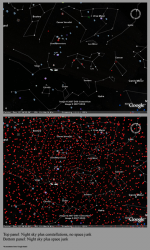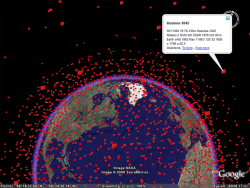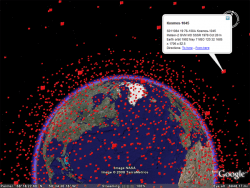Kessler Syndrome could be a frightening situation for space travel. No, it’s not a health risk to the human body in zero-G and it’s not a psychological disorder for astronauts spending too much time from home. Kessler Syndrome is the point at which space travel becomes impossible without hitting into a piece of space junk, jeopardizing missions and risking lives. In extreme predictions, space debris from our constant littering of low Earth orbit, collisions between bits of rubbish may become more and more frequent, causing a catastrophic cascade of debris multiplying exponentially, falling through the atmosphere and making space impassable.
In the meanwhile, space mission controllers must be acutely aware that there could be an odd bolt or piece of old satellite flying toward their spaceship at velocities faster than the fastest rifle shot. Spare a thought for the space debris trackers as they try to keep a record of the 9,000+ pieces of junk currently orbiting our planet… but wait a minute, Google Earth can give us a ringside seat!
Strict international civil aviation-style laws may need to be imposed on the worlds space agencies if future generations of the human race are going to make it in space. This stark warning comes from Tommaso Sgobba, Director of the International Association for the Advancement of Space Safety, who will be presenting his case to the United Nations in April. Sgobba’s main argument comes from the danger associated with the escalating accumulation of space debris in Earth orbit, should these high speed bits of junk hit a spaceship, satellite or an astronaut, death and disaster may ensue. It may get worse than this, possibly paralysing the Earth from having access to space at all.
“Failure to act now to regulate space to protect property and human life would be pure folly.” – Tommaso Sgobba.
Other scientists agree with Sgobba, recommending that future missions in to space abide by some strict codes of practice (possibly more strict than those imposed on international civil aviation) to drastically cut the rate of orbital littering by the 20 countries currently able to send stuff into space.
Even the most tightly controlled missions, such as the International Space Station, are expected to shed bits and pieces over the course of their lifetimes. Space junk comes in all shapes and sizes and can be anything from a small screw to entire dead satellites. Recorded examples of space junk include an old glove lost by Ed White during the first ever US space walk in 1965 (during the Gemini-4 mission), a camera that Michael Collins let slip in space in 1966 (during the Gemini-8 mission) and a pair of pliers that International Space Station astronaut Scott Parazynski dropped during an EVA last year.
Some space debris near misses include:
- Space Shuttle dodge: Space Shuttle Atlantis had to avoid collision with a piece of a Russian satellite by carrying out a seven second burn of its engines in 1991.
- Aircraft scare: Bits of an Russian ex-spy satellite fell through the atmosphere coming very close to a Latin American Airbus, carrying 270 passengers in 2006.
- Personal injury: fortunately there is only one documented account of someone being hit by a piece of debris on the ground. In 1997 a woman from Oklahoma was hit on the shoulder by a piece of a fuel tank from a Delta II rocket. She was unhurt and lived to tell the tail.
It is hoped that tighter controls on the rockets, satellites and spacecraft will slow the rate of junk increase, but the problem is already pretty worrying for long-term missions in orbit around the Earth. The two critical regions filling with debris are in low Earth and geosynchronous orbits, a few hundred and 22,300 miles high respectively. Low Earth orbit will cause problems for spacecraft to actually leave the atmosphere and geosynchronous orbit may hinder future communication satellite insertions.
To safeguard our access into space, and avoid an increase in debris-related incidents, action will need to be taken.
Google Earth-watch

During the research on this article, I came across some work being funded by Ministry of Culture of the Republic of Slovenia, Municipality of Ljubljana, where researchers are making debris location data available to the public via a plugin for the Google Earth application. According to the groups blog, the data is taken from a U.S. government-owned space observatory so known space debris (or as the blog calls it “pollution”, which it really is) can be tracked.
On experimenting with the new space debris folder, it really did strike home as to what a problem space junk is becoming. For starters, there is an impossibly thick near-Earth layer and a distinct ring representing the geosynchronous debris. Plus, each item can be selected and information on the individual bits of debris can be found out… see the screenshots to find out what I mean…

Get the space junk plugin for Google Earth (read Google Earth documentation to learn how to use this plugin).
News Source: Guardian.co.uk


Tomasso Sgobba, good luck, and much success. I congratulate you for speaking up.
To: john mitchell
“The first EVA was carried out by Alexey Leonov on March 18, 1965 from the Voskhod 2 spacecraft.”
You are totally right John, it was the first *US* space walk – corrected now.
Thanks, Ian
it’s quite necessary to lay down rules regarding space aviation..
good luck Sgobba!!
I hope the get this all fixed up… I want us to be able to go into space.
I’m not sure if Google developed this plugin intentionally to draw attention to the problem, or, if it was just something they came up with to say, “chalk up another one for Google!!”.
At any rate, if something like this doesn’t raise more than a few eyebrows, then maybe we’ll just be walking into quicksand anyway, ignoring the fact that we just saw someone sink beneath the earth hours earlier.
Could the present warming up of the atmosphere around our planet in fact be due to all this trash orbiting around it ? I know it sounds strange to formulate such a hypothesis, especially when one knows that glacial eras are -we are told- induced by the thick dust that isolates the earth from sun rays, as happened many times already, i.e. some million years ago after the impact of an asteroid, causing the dinosaures to disapear. I mean warming up could be a forerunning sign… If so, then indeed, unless we clean our trash obscurating our access to sun rays and space altogether, our life on earth will become quite a hell. Mr Tommaso Sgobba’s words in above article should be given urgent and due attention by the nations: “Failure to act now to regulate space to protect property and human life would be pure folly.” It is also a matter of survival, and I do hope our politicians will show some political will to address these vital matters…
I was just staring at the picture in this report and suddenly niticed how uniform it is. Then I thought that that souldn’t be the case, orbits are selective for purpose and they can’t leave uniform debris.
Am I wrong or is this picture inaccurate?
Barry
Ed White made the first US Space Walk.
The first EVA was carried out by Alexey Leonov on March 18, 1965 from the Voskhod 2 spacecraft.
(from Wikipedia)
One thought I have had for some time now regarding the age of the universe and our observances is this:
If the universe is roughly 13.5 billion years old and we can see, for sake of argument 11 billion years into the past and light speed equals distance and time, how can we gaze into the past six months later and see the same distance of time and space 180 degrees in the opposite direction. It to me is a quagmire. We are not at the center of the universe. We are not the destination of billions of years of light travel.
Every time I think about the concept of red shift, light speed and time and this problem I have, my head hurts and I can’t conceive of a logical answer.
If anyone has one, please feel free to free me from this headache.
Barry
Kessler Syndrome. It’s a helluvathing, hey?
Well, guess we have to vacuum up the vacuum of space. Its an undeniable testament to mankind’s mindset towards polluting whatever environment we find.
Flashback: The Matrix. Mr. Smith interrogating Morpheus. “You are not mammals. Mammals always harmonize with their environment. You use up and pollute your environment and move to another one when it no longer supports you. There is one species on Earth which behaves as you humans. A virus.”
We best be getting the SailNet built to start sweeping up the orbits.
Irwin cracks me up. I bet he gets some action from the astrology folks.
But seriously, Johnny Blues is right on. There probably is money to be made from cleaning up debris in Earth orbit. The more famous objects like Ed White’s glove and Mike Collins camera would be snapped up by collectors, and a company could clean up orbital debris of the just plain junk and sell those locations to anyone wanting to put up a satellite. Orbital real estate, if you will.
A major space travel challenge related to space junk will be avoidance (which really isn’t practical for unseen material) and physical deflection. Has any science agency proposed a means of junk deflection? If a fool-proof means of deflection can’t be developed, then it seems highly probable that all extended deep space flights will eventually come into high-velocity contact with a small or large piece of something wreaking havoc on the vehicle. Space is not as empty as we think. Our very local space sojouns have been very lucky, unless the disappearance of a few probes have fallen victim to space debris.
NOW YOU CAN HAVE A PIECE OF SPACE JUNK NAMED AFTER YOU!
FOR A MERE $39.98 (no C.O.D.s, please,) I WILL REGISTER YOUR NAME AND ASSIGN YOU A PIECE OF SPACE JUNK OF YOUR VERY OWN THAT WILL IMMORTALIZE YOU FOREVER. NOW YOUR NAME CAN BE COSMIC, TOO! YOU WILL RECEIVE A HANDSOME EMBOSSED CERTIFICATE SUITABLE FOR FRAMING.
Right on Johnny Blues.
There is big money to be made cleaning up the trash. Maybe the Mafia are interested in this one?
There may be a market for a space vacuum cleaner soon soon .
Bring out my Deep Space Dyson cleaner!!
Seriously, I’ve always said, this situation poses a FAR greater threat to the human population than wild, crackpot theories about ‘killer asteroids’ (TU 2044 was it?)
Simple probabilities dictates if we keep throwing junk into space (earth orbit) some poor sap in a space craft will hit something.
Good on those trying to lay down some rules.
I second on the statement that the debris looks too uniform. Surely there should be more around the ecliptic than at the poles?
Also I love how on the screenshot on google earth provides a link to get directions to space junk object #417. I can only imagine what they would say: “turn left to retrograde minus 13 degrees, initiate 10 second burn…”
[i]Johnny Blues Says:
February 25th, 2008 at 4:28 am
Well, guess we have to vacuum up the vacuum of space. Its an undeniable testament to mankind’s mindset towards polluting whatever environment we find.[/i]
Make that “a testament to mankind’s knack for being careless about stuff” and you’ve got my vote.
In my opinion, there’s no evil behind what’s being done, no “polluting on purpose” in that sort of case, more of a carelessness and definitely some pure stupidity. Sort of like when people think that a drop in the ocean, or a vote at the presidentials, doesn’t really make a difference. Geez, people, sometimes !!
Magnets.
carelessness always make the world more miserable. So all of us must not doubt if one day, earth and the human kind, will be in some kind of situation, that will make us pay.
Thinking things that might happened to earth, really scares us all but, BUT space galaxy is a very big part of atmosphere for us to protect the earth from its future problems, like for example, an asteroid. scientist only knows what they observes, but thats only base on there observation, HYPOTHESIS or a GOOD GUESS as the way they call it, but no one really knows what will happen to our mother earth in the near future.
This is the first time I comment here and I should say you share genuine, and quality information for bloggers! Great job.
p.s. You have a very good template . Where have you got it from?